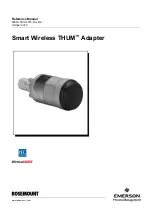
Emulex Virtual Fabric Adapter (CFFh) for IBM BladeCenter
3
IPv4/IPv6 TCP, UDP checksum offload
z
Large send offload (LSO)
z
Large receive offload
z
Receive side scaling (RSS)
z
IPV4 TCP Chimney Offload
z
VLAN insertion and extraction
z
Jumbo frames up to 9000 bytes
z
Load balancing and failover support including adapter fault tolerance (AFT), switch fault tolerance
z
(SFT), adaptive load balancing (ALB), teaming support, and IEEE 802.3ad
Enhanced Ethernet (draft)
z
Enhanced Transmission Selection (ETS) (P802.1Qaz)
z
Priority-based Flow Control (PFC) (P802.1Qbb)
z
Data Center Bridging Capabilities eXchange Protocol, CIN-DCBX and CEE-DCBX (P802.1Qaz)
z
iSCSI and FCoE support as a future feature entitlement purchase
z
Configurable from the BNT Virtual Fabric 10Gb Switch Module
z
Modes of operation
The expansion card has two modes of operation: standard physical port mode (pNIC) and virtual NIC
(vNIC) mode.
In vNIC mode, each physical port appears to the blade server as four virtual NICs. The default
z
bandwidth for each vNIC is 2.5 Gbps. Bandwidth for each vNIC can be configured from 100 Mbps to
10 Gbps, up to a maximum of 10 Gb per virtual port. vNICs can also be configured to have 0
bandwidth if you must allocate the available bandwidth to fewer than eight vNICs. To support vNIC
mode operation, the expansion card must communicate with the BNT Virtual Fabric 10Gb Switch
Module, which provides independent control for each vNIC.
In pNIC mode, the expansion card can operate as a standard 10 Gbps or 1 Gbps 2-port Ethernet
z
expansion card. When in pNIC mode, the expansion card functions with any available 10 Gb switch or
10 Gb pass-thru module installed in I/O module bays 7 and 9.
A future entitlement purchase will allow for up to two FCoE ports or two iSCSI ports. FCoE and iSCSI
ports can be used in combination with up to six Ethernet ports in vNIC mode, up to a maximum of
eight total virtual ports.
Operating environment
This adapter complies with temperature rating requirements for BladeCenter H and BladeCenter HT
chassis and is supported in the following environment:
Temperature - Operating:
z
10 to 52° C (50 to 125° F) at an altitude of 0 to 914 m (0 to 3,000 ft)
z
10 to 49° C (50 to 120° F) at an altitude of 0 to 3,000 m (0 to 10,000 ft)
z
Temperature - Non-operating:
z
40 to 65°C (-40 to 149° F) at an altitude of 0 to 12,000 m (0 to 39,370 ft)
z
Humidity
z
Operating: 8 to 80%, noncondensing
z
Non-operating: 5 to 80%, noncondensing
z




























